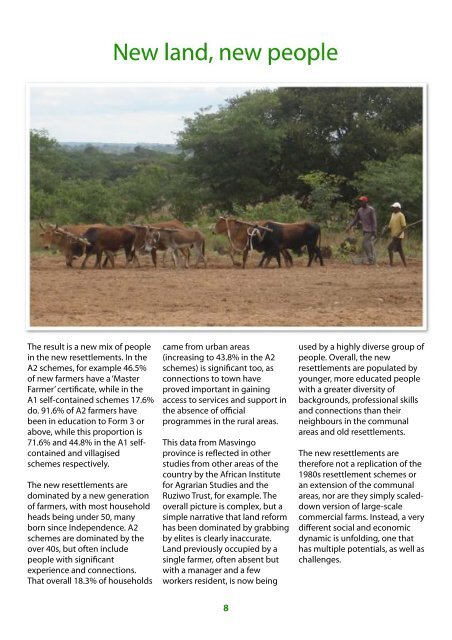Zimbabwe's Land Reform
Zimbabwe's Land Reform
Zimbabwe's Land Reform
Create successful ePaper yourself
Turn your PDF publications into a flip-book with our unique Google optimized e-Paper software.
The result is a new mix of people<br />
in the new resettlements. In the<br />
A2 schemes, for example 46.5%<br />
of new farmers have a ‘Master<br />
Farmer’ certificate, while in the<br />
A1 self-contained schemes 17.6%<br />
do. 91.6% of A2 farmers have<br />
been in education to Form 3 or<br />
above, while this proportion is<br />
71.6% and 44.8% in the A1 selfcontained<br />
and villagised<br />
schemes respectively.<br />
The new resettlements are<br />
dominated by a new generation<br />
of farmers, with most household<br />
heads being under 50, many<br />
born since Independence. A2<br />
schemes are dominated by the<br />
over 40s, but often include<br />
people with significant<br />
experience and connections.<br />
That overall 18.3% of households<br />
came from urban areas<br />
(increasing to 43.8% in the A2<br />
schemes) is significant too, as<br />
connections to town have<br />
proved important in gaining<br />
access to services and support in<br />
the absence of official<br />
programmes in the rural areas.<br />
This data from Masvingo<br />
province is reflected in other<br />
studies from other areas of the<br />
country by the African Institute<br />
for Agrarian Studies and the<br />
Ruziwo Trust, for example. The<br />
overall picture is complex, but a<br />
simple narrative that land reform<br />
has been dominated by grabbing<br />
by elites is clearly inaccurate.<br />
<strong>Land</strong> previously occupied by a<br />
single farmer, often absent but<br />
with a manager and a few<br />
workers resident, is now being<br />
used by a highly diverse group of<br />
people. Overall, the new<br />
resettlements are populated by<br />
younger, more educated people<br />
with a greater diversity of<br />
backgrounds, professional skills<br />
and connections than their<br />
neighbours in the communal<br />
areas and old resettlements.<br />
The new resettlements are<br />
therefore not a replication of the<br />
1980s resettlement schemes or<br />
an extension of the communal<br />
areas, nor are they simply scaleddown<br />
version of large-scale<br />
commercial farms. Instead, a very<br />
different social and economic<br />
dynamic is unfolding, one that<br />
has multiple potentials, as well as<br />
challenges.<br />
8

















